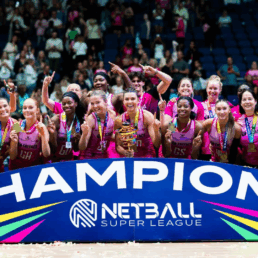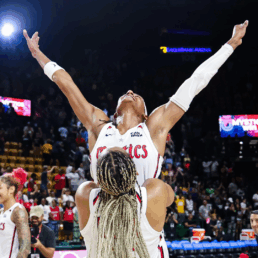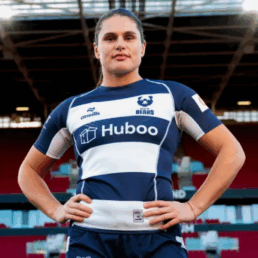Image source: © Jan Virt / IFSC
Women’s sport isn’t a moment, it’s a movement.
I’ve heard this phrase echo across various panels over the past year, and it rings true – there has been a rise in attendance, increased media coverage and an explosion of visibility.
But here’s my reservation. When we say women’s sport is thriving, what we’re usually talking about is football, rugby, basketball and perhaps netball. Here’s some data to back up my thinking…
- Global revenue from elite women’s sport has skyrocketed from US$981m in 2023 to US$1.88b in 2024. It’s projected to hit US$2.35b in 2025, an incredible ~240% increase in just four years. Source
- Women’s football saw its commercial revenue jump from US$740m in 2024 to US$820m in 2025 and it remains one of the top two revenue drivers. Source
- Women’s Rugby World Cup 2025 has already sold a record number of tickets (over 275,000 tickets to date). Source
- Women’s basketball is expected to generate US$1.03b in 2025, surpassing women’s football in revenue share. Source
- Netball Super League’s TV audience on Sky Sports rose +229% year-on-year; digital engagement saw a rise of +524% TikTok views and +47% growth on Instagram. Source

Image source: Netball Super League

Image source: WNBA

Image source: BBC Sport
But what about other ‘emerging’ sports?
Emerging sports are those gaining momentum but still operating outside the mainstream spotlight (e.g. visibility, investment, commercial backing).
Sport climbing, skateboarding, BMX (racing and freestyle) and cricket are all examples of sports seeing increased Google search interest and a growing female presence on social media.
These emerging sports are often overlooked in the conversation. They may have niche visibility, funding and strategic attention, but they are not niche in terms of participation or passion. So, what can they do to gain their share of the spotlight?
This article explores how emerging women’s sports can succeed.
What emerging women’s sports can do
To grow sustainably, emerging women’s sports need more than passion and potential – they need a strategic approach to marketing and audience building.
Marketing experts Binet and Field suggest that success lies on balancing “the long and the short of it”: combining short-term activation with long-term brand building . By doing both, short-term activations such as sales become more effective over time.
Why does it matter? Because focusing too heavily on short-term wins (e.g. ticket sales, one-off events, viral moments) can undermine long-term growth. Conversely, investing solely in long-term visibility without driving immediate engagement can also stall momentum.
Binet and Field’s research indicates that the ideal split for most brands is 60% long-term brand building and 40% short-term activation. Although emerging sports may not have huge budgets, the principle still applies:
1. build the brand to grow awareness and love over time
2. activate tactically to drive action and engagement now
This concept is directly connected with another key idea in marketing science: ‘mental availability’, coined by Romaniuk and Sharp from the Ehrenberg-Bass Institute.
Mental availability refers to the likelihood that a sport will come to mind in relevant decision-making moments such as buying a ticket, tuning into a stream or following a team. It’s not just about being known, it’s about being top of mind and easy to recall.
Why is this important for emerging women’s sports?
Campaigns that increase mental availability also improve key business metrics – from viewership and ticket sales to sponsorship interest and fan loyalty. In other words, long-term brand building not only boosts but also strengthens short-term performance.
What does that look like in practice for women’s emerging sports?

Short-term
Binet and Field emphasise that the primary factor for achieving short-term wins is the use of direct response activation tactics, i.e. strategies that trigger immediate behavioural responses (e.g. fan engagement, influencer collaborations, giveaways). Such tactics create short bursts of engagement, expand audiences and generate momentum – especially on digital.
1. Highlight micro moments & underrated stories
Use social media to display unexpected wins, rising talent or glimpses behind-the-scenes. Start with a strong hook in the first line. These human-centred stories spark emotion and quick engagement without the need for big budgets or extensive match coverage.
2. Leverage relevant cultural or sporting moments
Align your content with broader conversations, from International Women’s Day to viral trends. Even if you’re not the headline act, offering a fresh, challenger perspective can lead to bigger shares, media pick-ups or follower spikes.
3. Launch a fast-action digital campaign with a clear CTA
Design a short campaign around a compelling reason to take action. Aim to drive clicks, comments or sign-ups through time-bound initiatives (e.g. features, countdowns to team reveals, interactive fan-led content).
Why?
- builds credibility and emotional connection (not just virality)
- works within the limited resources faced by many emerging sports
- prompts rapid digital actions (e.g. likes, shares, comments, follows, sign-ups)
Ultimately, impressions are what will drive growth. Do everything you can to ensure your digital content reaches as wide an audience as possible.
Example
Chelsea FC Women’s TikTok launch post.
Purpose: to share behind-the-scenes player content designed to spark immediate engagement and follower growth.
@chelseafc Welcome to TikTok, @Chelsea FC Women! 👋 #chelsea #cfc ♬ Hip Hop Background(814204) - Pavel
Long-term
The most important driver of long-term growth is still market penetration. In other words, the number of people aware of, interested in or actively engaging with your sport compared to the total potential audience.
The more people you reach, the more likely your sport is to grow – it’s that simple.
Market penetration goes beyond cultivating deep loyalty from a select few; it involves reaching as many people as possible, as often as possible. The more people who know your sport exists, the more likely they are to engage with, support or invest in it.
1. Build athlete brands as well as team accounts
Fans follow individuals first, not properties.
Athletes are your most powerful storytellers. In women’s sport, there is a significant shift towards fans following personalities rather than teams. Take the ‘Caitlin Clark effect’, which even has its own Wikipedia page. Her popularity has driven record-breaking attendance and TV ratings and contributed to GDP uplift in Iowa estimated between US$14m–US$52m.
Ilona Maher exemplifies this trend, too. She is now the most followed active rugby play of all time – men and women – boasting 5m followers on Instagram and 3.6m on TikTok.
Athletes who combine sporting excellence with humour, insight and cultural relevance present great opportunities for women’s sport.
What you can do
- provide athletes with media training and social content support
- co-create storytelling content
- encourage athletes to engage with trending non-sport topics (e.g. music, fashion, beauty) to broaden their audience
2. Develop distinct brand identity for the sport itself
Yes, you might have a men’s league or teams that mirror your game – but remember, you’re not merely the ‘female version’ of a men’s sport. Women’s sport is a distinct movement, with its specific community, culture and energy.
And that matters.
Even when the rules are the same, the fandom, behaviours and reasons people engage can be very different. That means your women’s sport deserves more than a copy-and-paste strategy – it needs its own approach, its own voice and its own vision.
Long-term brand growth relies on being recognisable and consistent in your mission, tone and visuals. This starts with a deep understanding of your audience, investing in research to uncover their values, how they connect and where the digital opportunities lie.
The reality is straightforward: memorable brands are talked about, forgettable ones are not.
Take SOOO as an example. I heard about it through word of mouth and online conversations, nothing else.
What you can do
- develop a comprehensive brand strategy:
- diagnosis
- strategy
- tactics
- define your brand:
-
- develop a complete set of digital brand assets (e.g. logos, templates, messaging, design system)
- identify and target category entry points, those moments when fans might think about sport (e.g. “I want to try something new”, “What’s on this weekend?”, “I want to support women in sport”)
- recognise own both internal and external triggers that enhance mental availability – what prompts someone to think about your sport?
- ensure consistent association with women’s sport as a category by aiming to show up wherever women’s sport is discussed
- launch long-running campaigns that build memorable brand memory structures and identity.
3. Invest in high-quality, evergreen content
Emotive, narrative-led content is proven to drive long-term brand preference and keep your name in conversations long after the final whistle.
While short-form social is essential, it doesn’t replace the value of rich, story-led content that builds salient and emotional connections. Consider documentary series, athlete profiles or original podcasts.
What you can do
- produce evergreen content that fans will revisit or that media can reference
- use storytelling formats like docuseries, blogs or audio stories
- create an annual calendar of ‘tentpole’ content moments (e.g. International Day of Girls in Sport, national championships)
Example
UEFA Women’s Champions League ‘Queens of Football’ campaign.
Purpose: to create culturally rich, emotionally driven content that highlights star players as a sort of royalty and builds long-term brand identity.
Some final thoughts…
It’s clear that growing an emerging women’s sport requires more than a few viral posts or one-off campaigns. Time is a key factor in all of this. Football’s popularity is rooted in heritage, family and culture, elements that develop with time. I have no doubt that if women’s sport properties establish their position and remain consistent and patient, their popularity will continue to thrive.
The journey may take time, but the stakes have never been clearer: invest in visibility or risk being left behind.
She Moves The Game is our commitment to increasing the visibility and representation of women in sport – on and off the field. Find out more.
Jess Reus
I am a food-loving, dog-appreciating, hockey player.
My most memorable sporting moment is…
Full on face planting on the Spine Ramp at FISE Montpellier in front of a crowd of 6,000 people and a load of professional Skateboarders...
I am happiest when …
I have food in my mouth.
The sports person that best represents me is …
Kate Richardson-Walsh.
The three things at the top of my bucket list are …
1. Travel around China and Japan
2. Meet Trixie Mattel
3. Learn a second language
A quote I live my life by is …
“They say I'm the Hottest MC in the Game. If you label me that, I will live up to it. Trust me.” – Lil Wayne.





